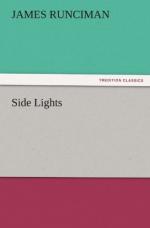Mrs. Raddle and Mrs. Mackenzie are as far apart as
two creatures may be; nevertheless they are veritable
specimens of the British shrew, and it should be within
the resources of civilisation to find a definition
capable of fitting both of them. As for Queen
Elizabeth—that splendid, false, able, cruel,
and inexorable shrew—she requires the space
of volumes to give even the shadow of her personality
and powers. She has puzzled some of the wisest
and most learned of men. She was truly royal,
and wholly deceitful; self-controlled at times, and
madly passionate at others; a lover of pure literature,
and yet terribly free in her own writings; kind to
her dependants, yet capable of aiming a violent blow
at some courtier whom she had caressed a moment before
the blow came; an icy virgin, and a confirmed and
audacious flirt; a generous mistress, and an odious
miser; a free giver to those near her, and a skinflint
who let the sailors who saved her country lie rotting
to death in the open streets of Ramsgate because she
could not find in her heart to give them either medical
attendance or shelter. Was there ever such another
being known beneath the glimpses of the moon?
Some might call her superhuman; I am more inclined
to regard her as inhuman, for her blending of characteristics
is not like anything ever seen before or since among
the children of men. She was a shrew—a
magnificent, enigmatic shrew, who was perhaps the
more fitted to rule a kingdom which was in a state
of transition in that she was lacking in all sense
of pity, shame, or remorse. She was the apotheosis
of the shrew, and no one of the tribe can ever be
like unto her again. Carlyle’s Termagant
of Spain is a shadowy figure that flits through all
the note-books on Frederick, but we never get so near
to her as we do to Elizabeth, and she remains to us
as a vast shape that gibbers and threatens and gesticulates
in the realms of the dead. Jael, the wife of
Heber the Kenite, must have been a terrible shrew,
and I should think that Heber was not master in the
house where Sisera died. The calm deliberation,
the preliminary coaxing, the quick, cool determination,
and the final shrill exultation which was reflected
in Deborah’s song all speak of the shrew.
Thackeray had a morbid delight in dwelling on the
species, and we know that all of his portraits were
taken from real life. If he really was intimate
with all of the cruel figures that he draws, then
I could pardon him for manifesting the most ferocious
of cynicisms even if he had been a cynic—which
he was not. The Campaigner, Mrs. Clapp, the landlady
in “Vanity Fair,” Mrs. Baynes, and all
the rest of the deplorable bevy rest like nightmares
upon our memory. Dickens always made the shrew
laughable, so that we can hardly spare pity for the
poor Snagsbys and Raddles and Crupps, or any of her
victims in that wonderful gallery; but Thackeray’s,
Trollope’s, Charles Reade’s, Mrs. Oliphant’s,
and even Miss Broughton’s shrews are always
odious, and they all seem to start from the page alive.




